Study on the Precise Displacement Controlling Method for a Suspended Deck in the Hanger Replacement Process of an Arch Bridge
Abstract
:1. Introduction
2. Theoretical Modelling Establishment of the Hanger Replacement Process
2.1. Structural Equivalence
- .
2.2. Calculation of Hanger Removal Process
2.2.1. Initial State
2.2.2. The Time Pocket Hanging
2.2.3. The Time Cutting
2.2.4. Displacement Control
2.3. Calculation of the New Hanger Installation Process
2.3.1. Initial State
2.3.2. The Times Tension of the New Hanger
2.3.3. The Times Unloading of the Pocket Hanging Hanger
2.3.4. Displacement Control
3. Case Study
3.1. Old Hanger Demolition Process
3.2. New Hanger Installation Process
3.3. Compared with the FEM
- (1)
- In the FEM, the cutting of the old hanger actually involves the simulation of the geometric nonlinearity. It is noted that the mentioned nonlinearity refers to the geometric nonlinearity caused by the cross-sectional area change of the hanger and the non-stress length change of the hanger in the hanger demolition and tension process. It is usually time-consuming to simulate the nonlinearity by the finite element method, and there is no good solution for the simulation of the non-stress length change of the hanger in the finite element method. However, the proposed method in this paper can not only accurately calculate the results, but is also more efficient.
- (2)
- In order to simplify, several repeated elements are usually established at the same position of the old hanger. These elements have the same parameters except the cross-sectional area. The cutting process of the old hanger is simulated by activating the hanger corresponding to the area of the construction stage in different construction stages and passivating the hanger of the previous construction stage. It is also important to note that the element needs to be activated along the initial tangential displacement of the member.
- (3)
- It is relatively easy to simulate the process of the installation of the new hanger because it does not involve the geometric nonlinearity of the structure. However, the method of external force replacement is needed when the temporary hanger force is transformed into the new hanger force. It is also noted that the hanger replacement implies a mutual effect in the side hangers. This is a linear effect, and a secondary effect of nonlinearity can depend only on the dissipative role of the attachments, joints, and operative methodologies, which is not considered in this study but will be discussed in a future study.
- (1)
- The trend of the finite element calculation results was basically consistent with the measured results, but the deviation between the measured and FEM results was still large, up to 10%. The main reason is that there were some differences in the material parameters and boundary conditions between the finite element model and the actual structure. However, if one wants to make the parameters in the finite element model consistent with the actual structural, a lot of field tests and calculation work would be required, so FEM is not conducive to engineering applications in simulating the hanger replacement process.
- (2)
- It took 55 min and 25 min, respectively, to remove the hanger and install the new hanger by the finite element simulation. However, only a small amount of calculation time was needed to use the proposed method. At the same time, the results calculated by this method were closer to the measured values than the FEM, and the maximum error was only -3.94%. Thus, it was proved that the proposed method is fast and accurate.
4. Conclusions
- (1)
- The adopted equivalent model of hanger replacement by separating from the overall model in this paper was accurate, and only partial boundary conditions need to be considered in practical application to get accurate results.
- (2)
- In the hanger replacement process of an arch bridge based on the pocket hanging method, the cumulative displacement increased and decreased alternately, and the corresponding variation values were basically the same during the new hanger installation process using equal step tensioning and unloading, which would achieve a satisfactory result and meet the requirements.
- (3)
- Although the trend of the finite element calculation results was consistent with the measured results, the deviation between them was still large. By comparison, the calculated result using the proposed method were fast and accurate enough through the practical engineering verification, and the hanger replacement was feasible under the precise displacement control.
Author Contributions
Funding
Institutional Review Board Statement
Informed Consent Statement
Data Availability Statement
Acknowledgments
Conflicts of Interest
References
- Zhang, D.Y.; Li, X.; Yan, W.M.; Xie, W.C.; Pandey, M.D. Stochastic seismic analysis of a concrete-filled steel tubular (CFST) arch bridge under tridirectional multiple excitations. Eng. Struct. 2013, 52, 355–371. [Google Scholar] [CrossRef]
- Usami, T.; Lu, Z.H.; Ge, H.B. A seismic upgrading method for steel arch bridges using buckling- restrained braces. Earthq. Eng. Struct. Dyn. 2005, 34, 471–496. [Google Scholar] [CrossRef]
- Xin, L.F.; Li, X.Z.; Zhang, Z.T.; Zhao, L.F. Seismic behavior of long-span concrete-filled steel tubular arch bridge subjected to near-fault fling-step motions. Eng. Struct. 2019, 180, 148–159. [Google Scholar] [CrossRef]
- Yang, K.K.; Yuan, J.; Shi, J.; Zheng, K.K.; Shen, J.Y. Stressing State Analysis on a Single Tube CFST Arch Under Spatial Loads. Appl. Sci. 2019, 9, 5039. [Google Scholar] [CrossRef] [Green Version]
- Liu, H.B.; Wang, L.L.; Tan, G.J.; Cheng, Y.C. An Adjusting Method for the Suspender Force of Continuous Beam Arch Combination Bridge Based on Influence Matrix. Appl. Mech. Mater. 2013, 275–277, 1082–1085. [Google Scholar] [CrossRef]
- Liu, Z.X.; Guo, T.; Huang, L.Y.; Pan, Z.H. Fatigue Life Evaluation on Short Suspenders of Long-Span Suspension Bridge with Central Clamps. J. Bridge Eng. 2017, 22, 04017074. [Google Scholar] [CrossRef]
- Zhao, H.W.; Ding, Y.L.; An, Y.H.; Li, A.Q. Transverse Dynamic Mechanical Behavior of Hangers in the Rigid Tied-Arch Bridge under Train Loads. J. Perform. Constr. Facil. 2017, 31, 04016072. [Google Scholar] [CrossRef]
- Bouaanani, N. Numerical investigation of the modal sensitivity of suspended cables with localized damage. J. Sound Vib. 2006, 292, 1015–1030. [Google Scholar] [CrossRef]
- Li, S.L.; Hu, P.Y.; Zhao, X.F.; Chen, K.J.; Li, J.K. Atmospheric corrosion performance of wire rope sling in a sulfur dioxide-polluted environment. Adv. Mech Eng. 2017, 9, 1687814017707479. [Google Scholar] [CrossRef] [Green Version]
- Mehrabi, A.B.; Ligozio, C.A.; Ciolko, A.T.; Wyatt, S.T. Evaluation, Rehabilitation Planning, and Stay-Cable Replacement Design for the Hale Boggs Bridge in Luling, Louisiana. J. Bridge Eng. 2010, 15, 364–372. [Google Scholar] [CrossRef]
- Lan, R.Y.; Jiang, G.F.; Wang, H.; Hao, T.Z.; Wang, L.L.; Liang, Q.X. Research on the Suspender Replacement Process of Arch Bridge Based on the Measured Displacement Correction. IEEE Access 2020, 8, 226952–226961. [Google Scholar] [CrossRef]
- Sun, Z.; Ning, S.W.; Shen, Y.F. Failure Investigation and Replacement Implementation of Short Suspenders in a Suspension Bridge. J. Bridge Eng. 2017, 22, 05017007. [Google Scholar] [CrossRef]
- Li, S.L.; Zhu, S.Y.; Xu, Y.L.; Chen, Z.W.; Li, H. Long-term condition assessment of suspenders under traffic loads based on structural monitoring system: Application to the Tsing Ma Bridge. Struct. Control. Health Monit. 2012, 19, 82–101. [Google Scholar] [CrossRef]
- Feng, D.M.; Mauch, C.; Summerville, S.; Fernandez, O. Suspender Replacement for a Signature Bridge. J. Bridge Eng. 2018, 23, 05018010. [Google Scholar] [CrossRef]
- Fu, Z.Q.; Ji, B.H.; Yang, M.Y.; Sun, H.B.; Maeno, H. Cable Replacement Method for Cable-Stayed Bridges Based on Sensitivity Analysis. J. Perform. Constr. Facil. 2015, 29, 04014085. [Google Scholar] [CrossRef]
- Crespi, P.; Zucca, M.; Valente, M. On the collapse evaluation of existing RC bridges exposed to corrosion under horizontal loads. Eng. Fail. Anal. 2020, 116, 104727. [Google Scholar] [CrossRef]
- Bossio, A.; Fabbrocino, F.; Monetta, T.; Lignola, G.P.; Prota, A.; Manfredi, G.; Bellucci, F. Corrosion effects on seismic capacity of reinforced concrete structures. Corros. Rev. 2019, 37, 45–56. [Google Scholar] [CrossRef]
- Zhuang, D.; Xiao, R.; Jia, L.; Sun, B. Failure analysis for overall stability against sliding and overturning of a girder bridge. Eng. Fail. Anal. 2020, 109, 104271. [Google Scholar] [CrossRef]
- Crespi, P.; Zucca, M.; Longarini, N.; Giordano, N. Seismic Assessment of Six Typologies of Existing RC Bridges. Infrastructures 2020, 5, 52. [Google Scholar] [CrossRef]
- Liu, Z.X.; Guo, T.; Hebdon, M.H.; Zhang, Z.L. Corrosion Fatigue Analysis and Reliability Assessment of Short Suspenders in Suspension and Arch Bridges. J. Perform. Constr. Facil. 2018, 32, 04018060. [Google Scholar] [CrossRef]
- Xiaomei, S.; Hongsheng, X.; Donghuang, Y. Optimization Research of Construction Process in Hanger Replacement of Arch Bridge without Interrupting Traffic. J. China Foreign Highw. 2019, 39, 107–111. [Google Scholar]
- Hossain, I.; Sluszka, P. Suspension bridge cable replacement. IABSE Symp. Rep. 2004, 88, 7–12. [Google Scholar]
- Ferreira, F.; Simoes, L. Automated synthesis of controlled cable-stayed footbridges with S-shaped deck. Adv. Eng. Softw 2020, 149, 102881. [Google Scholar] [CrossRef]
- Ferreira, F.; Simoes, L. Synthesis of three dimensional controlled cable-stayed bridges subject to seismic loading. Comput. Struct. 2020, 226, 106137. [Google Scholar] [CrossRef]
- Martins, A.M.B.; Simoes, L.M.C.; Negrao, J.H.J.O. Optimum design of concrete cable-stayed bridges. Eng. Optim. 2016, 48, 772–791. [Google Scholar] [CrossRef]
- Yao, W.J.; Yang, W.; Liu, X.Y. Analysis the Cable Replacement Method of Tianjin Yonghe Bridge. Appl. Mech. Mater. 2011, 71–78, 1383–1387. [Google Scholar] [CrossRef]
- Quansheng, S.; Haiying, Y.; Xiaoguang, G.; Jiawei, W.; Tong, W. Application of Kalman’s filtering method in construction control for cable replacement of the cable-stayed bridge. In Proceedings of the 2010 International Conference on Electrical and Control Engineering, Wuhan, China, 25–27 June 2010. [Google Scholar]
- Brown, J.L. Louisiana span set for complete cable replacement. Civ. Eng. 2008, 78, 24–27. [Google Scholar]
- Granata, M.F.; Arici, M.; Longo, G.; Recupero, A. Steel and composite tied-arch bridges: A conceptual approach to structural design. Proc. Inst. Civ. Eng.-Bridge Eng. 2021. [Google Scholar] [CrossRef]
- Recupero, A.; Granata, M.F. A Mixed Approach for Determination of Initial Cable Forces in Cable-Stayed Bridges and the Parameters Variability. Balt. J. Road Bridge Eng. 2015, 10, 141–150. [Google Scholar] [CrossRef]
- Granata, M.F.; Longo, G.; Recupero, A.; Arici, M. Construction sequence analysis of long-span cable-stayed bridges. Eng. Struct. 2018, 174, 267–281. [Google Scholar] [CrossRef]
- Granata, M.F.; Margiotta, P.; Recupero, A.; Arici, M. Partial Elastic Scheme Method in Cantilever Construction of Concrete Arch Bridges. J. Bridge Eng. 2013, 18, 663–672. [Google Scholar] [CrossRef]
- Mellier, E.; Joye, S.; Maillet, V. High Level Engineering for Stay Cable Replacement. IABSE Symp. Rep. 2009, 96, 230–239. [Google Scholar]
- Saeed, N.M.; Kwan, A.S.K. Displacement and internal force control in cable-stayed bridges. Proc. Inst. Civ. Eng.-Bridge Eng. 2018, 171, 63–76. [Google Scholar] [CrossRef]
- Setiadji, B.H.; Trong Nguyen, V.; Choi, Y.-W.; Yoon, J.-I.; Choi, K.-H.; Son, C.-H.; Kim, Y.-B.; Han, A.L.; Widodo, A.; Setiawan, J.D.; et al. Modeling, Identification, and Simulation of Positional Displacement Control for Ribbon Bridges. MATEC Web Conf. 2018, 159, 02026. [Google Scholar]
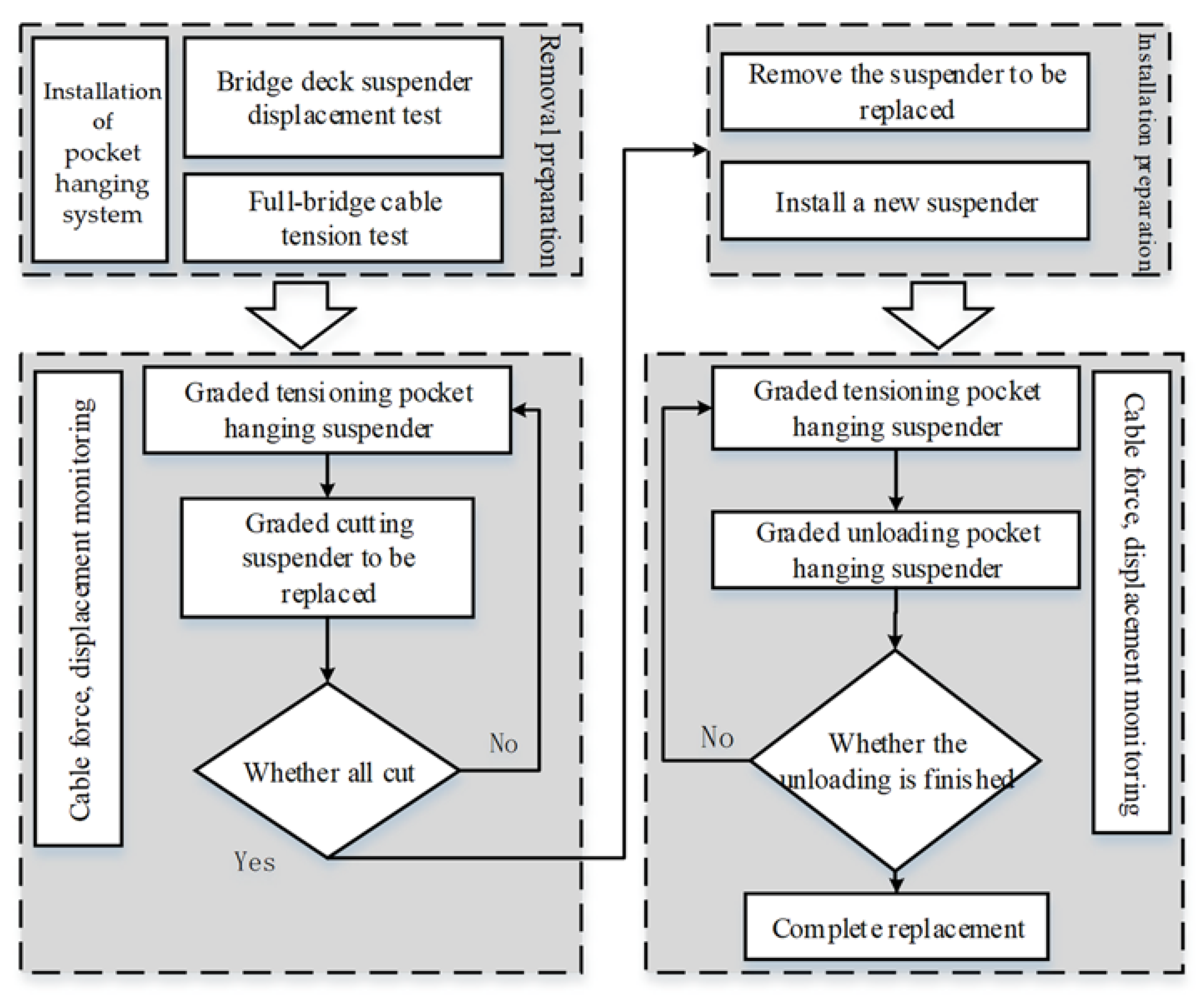
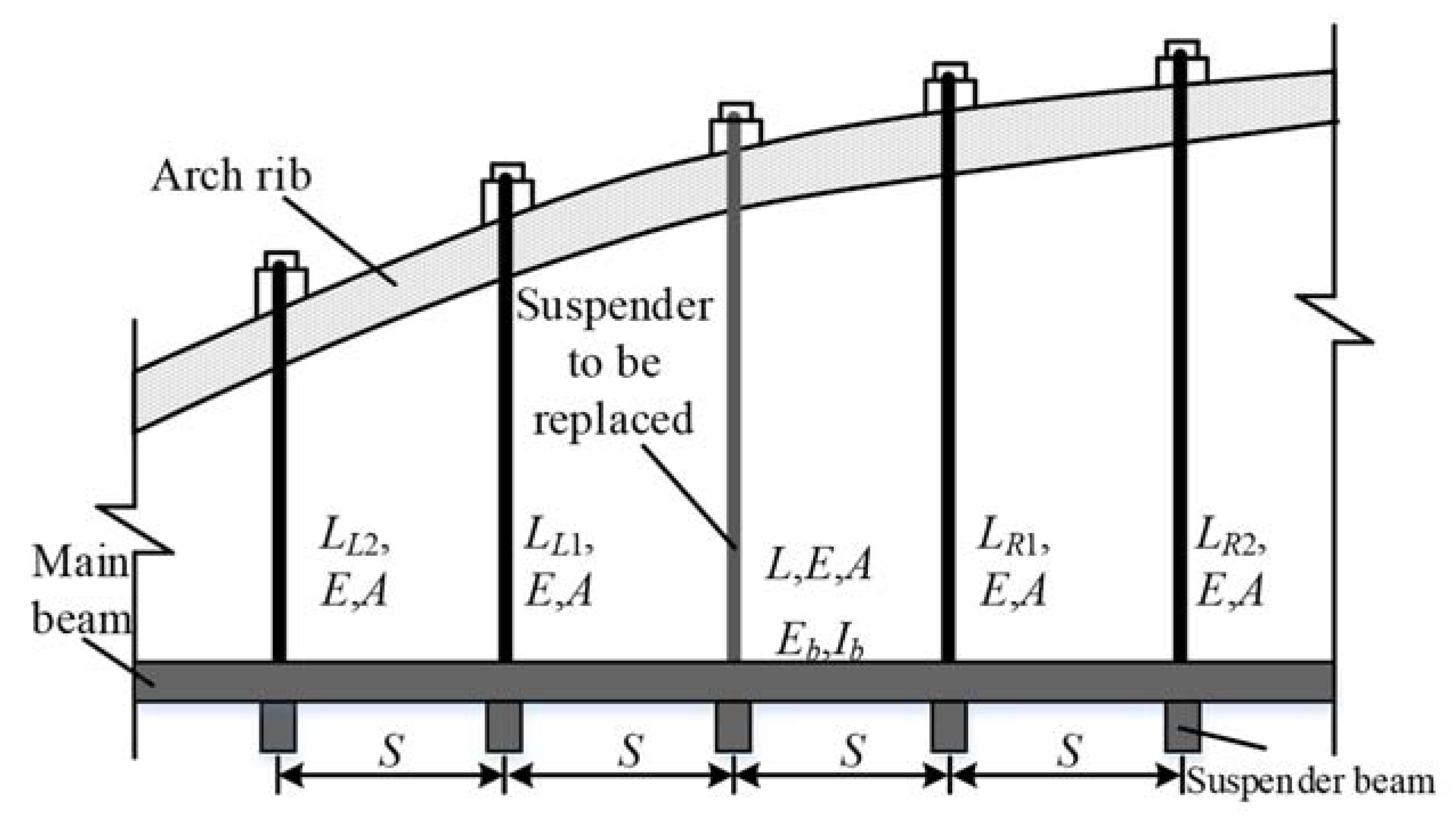

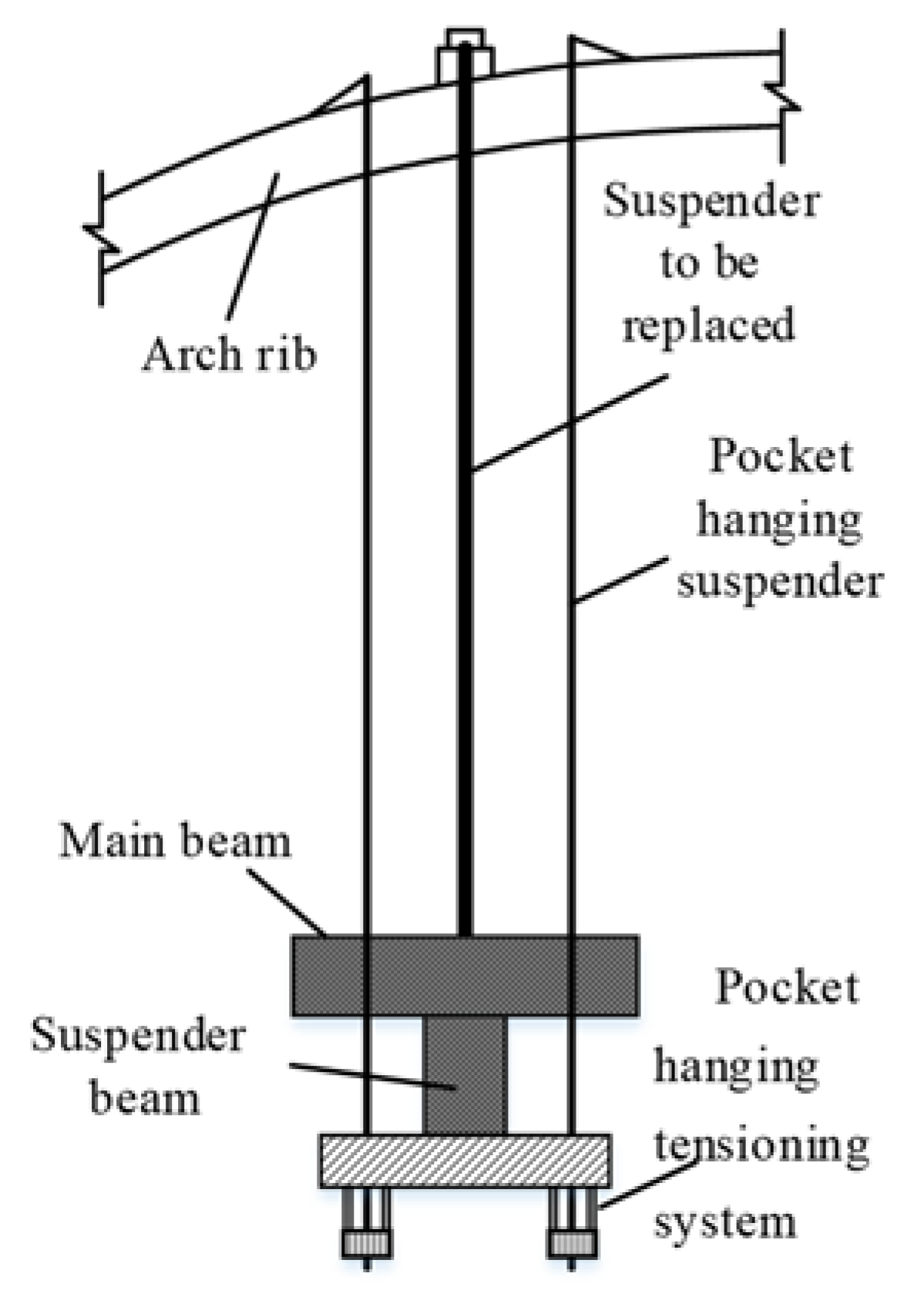
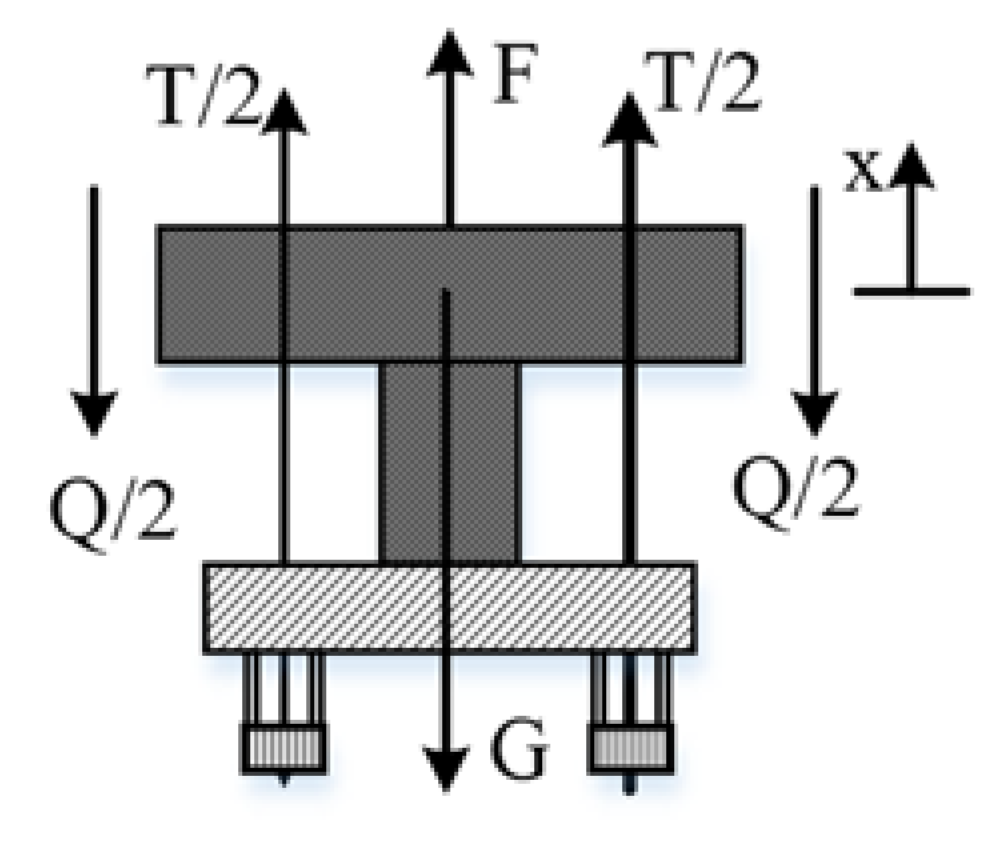
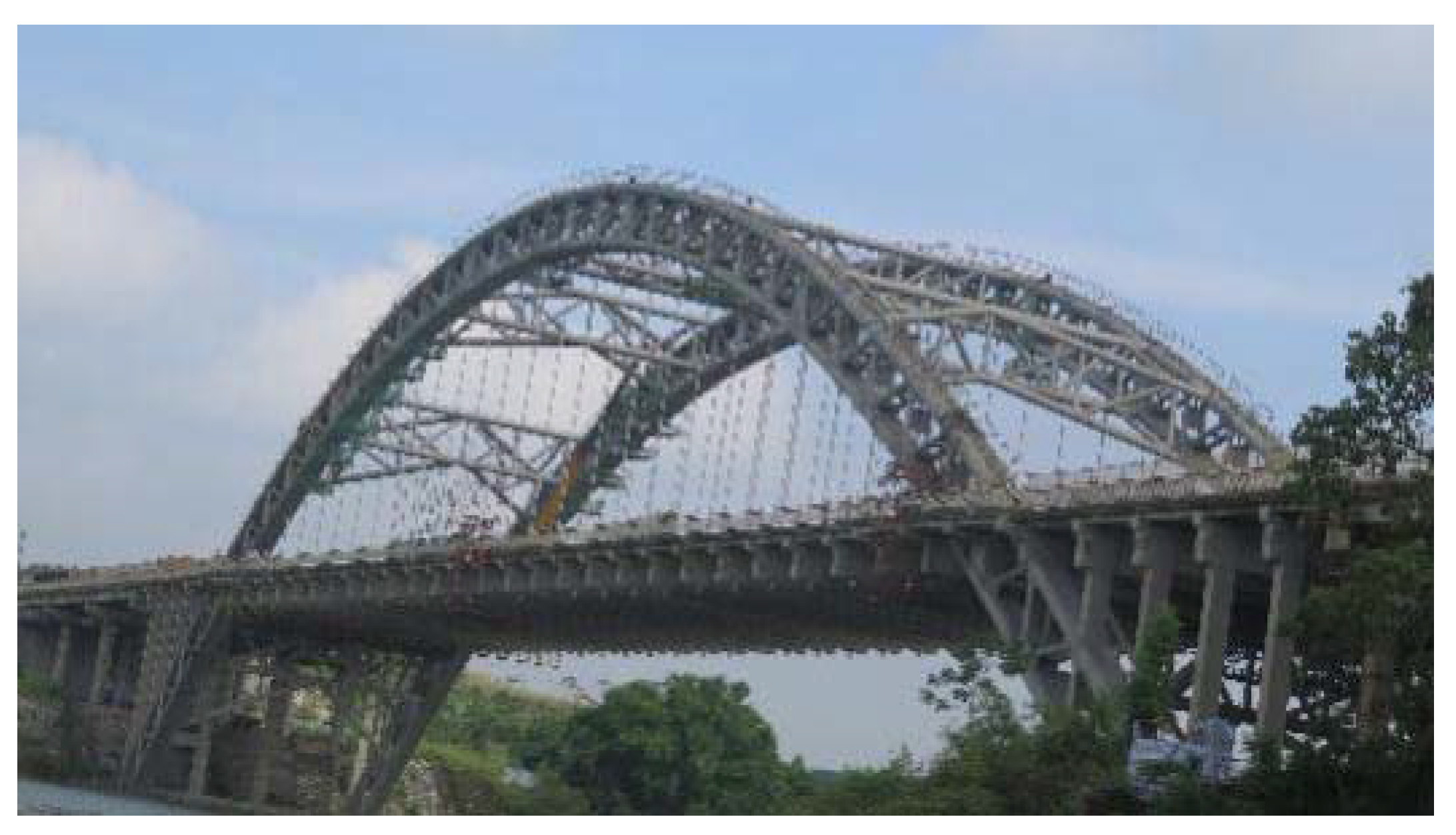
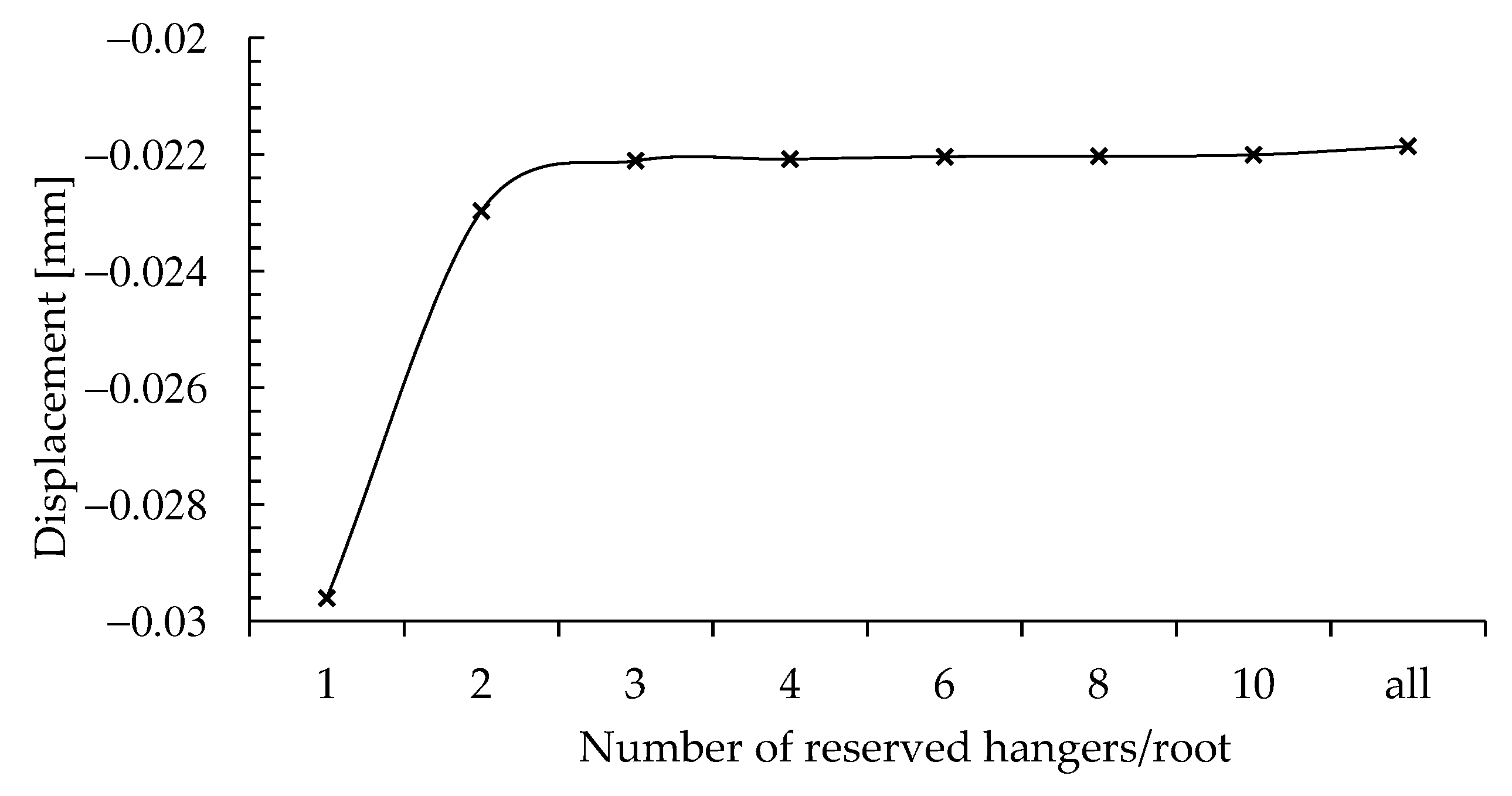
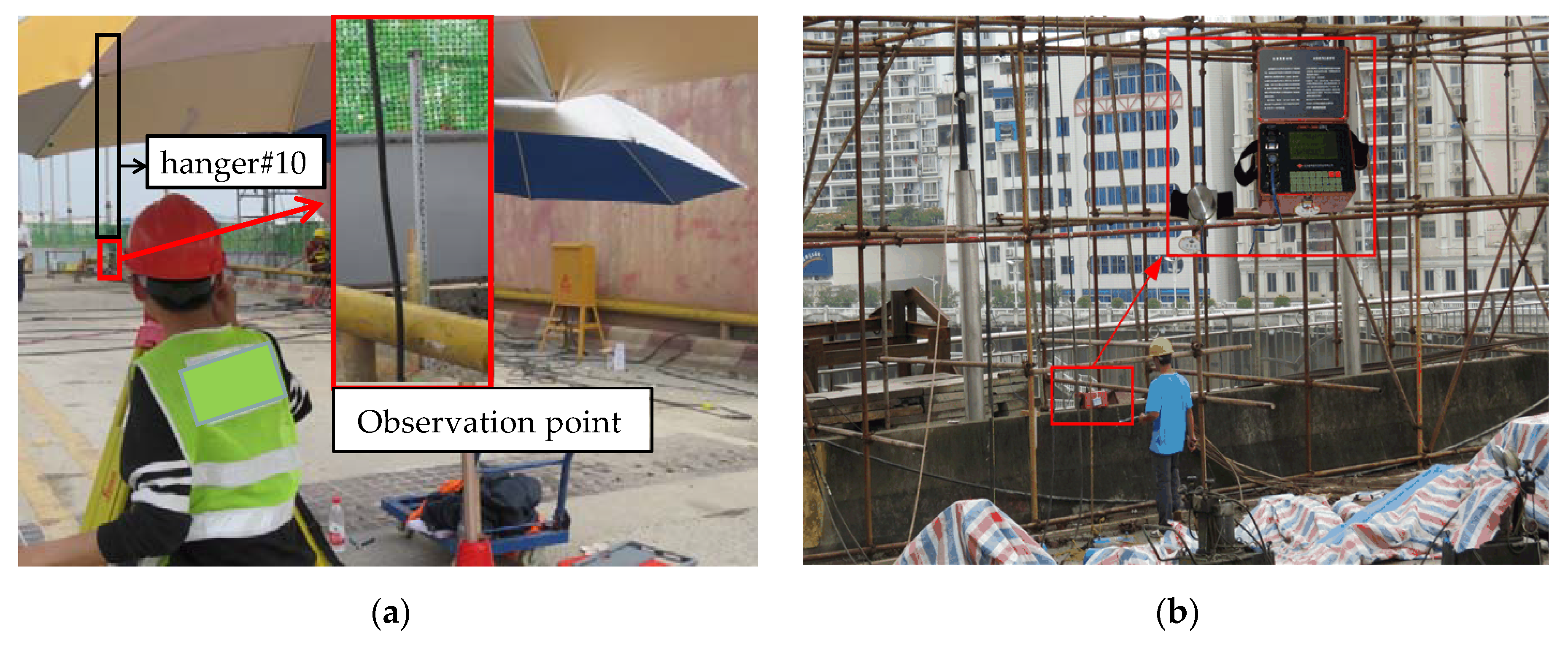

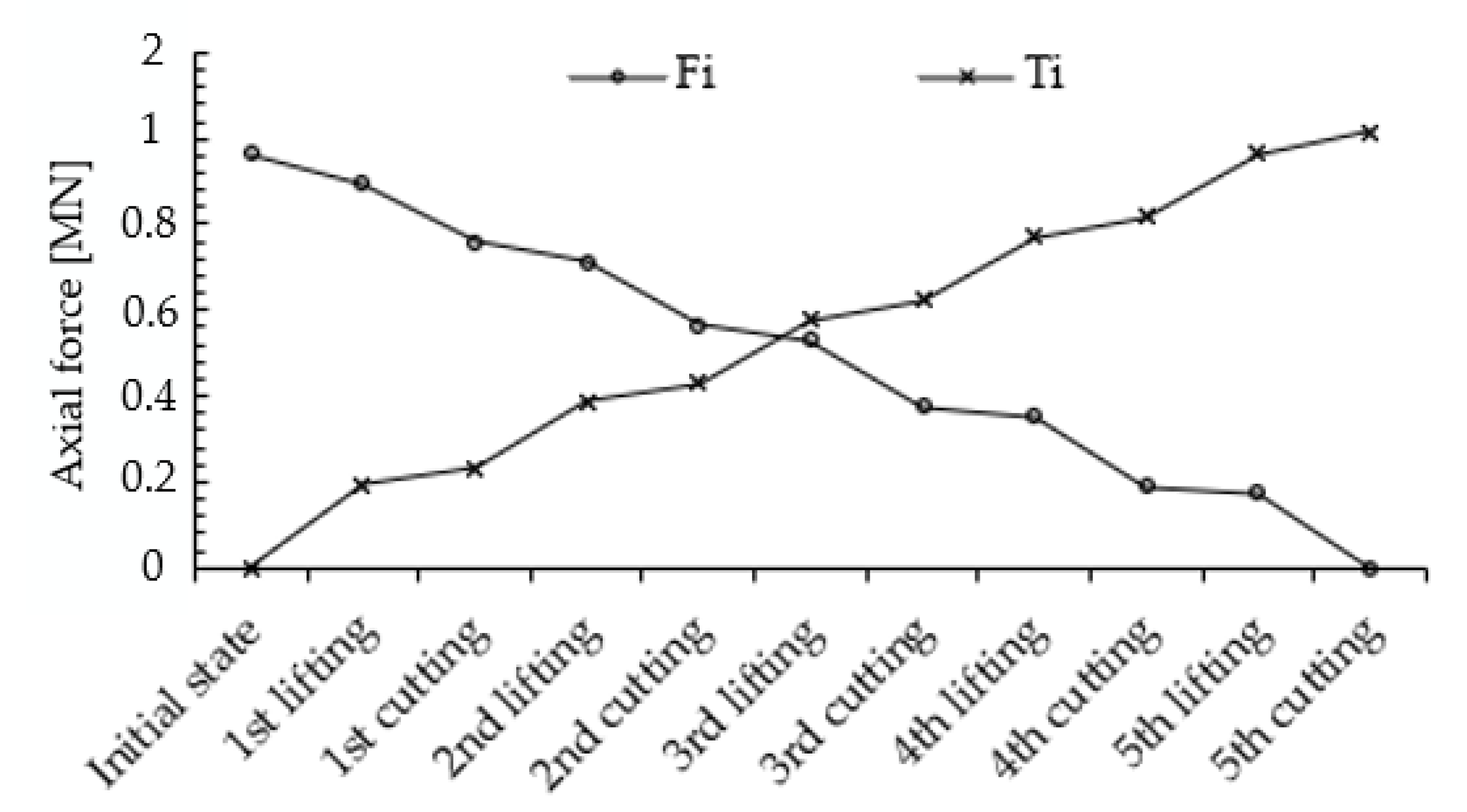
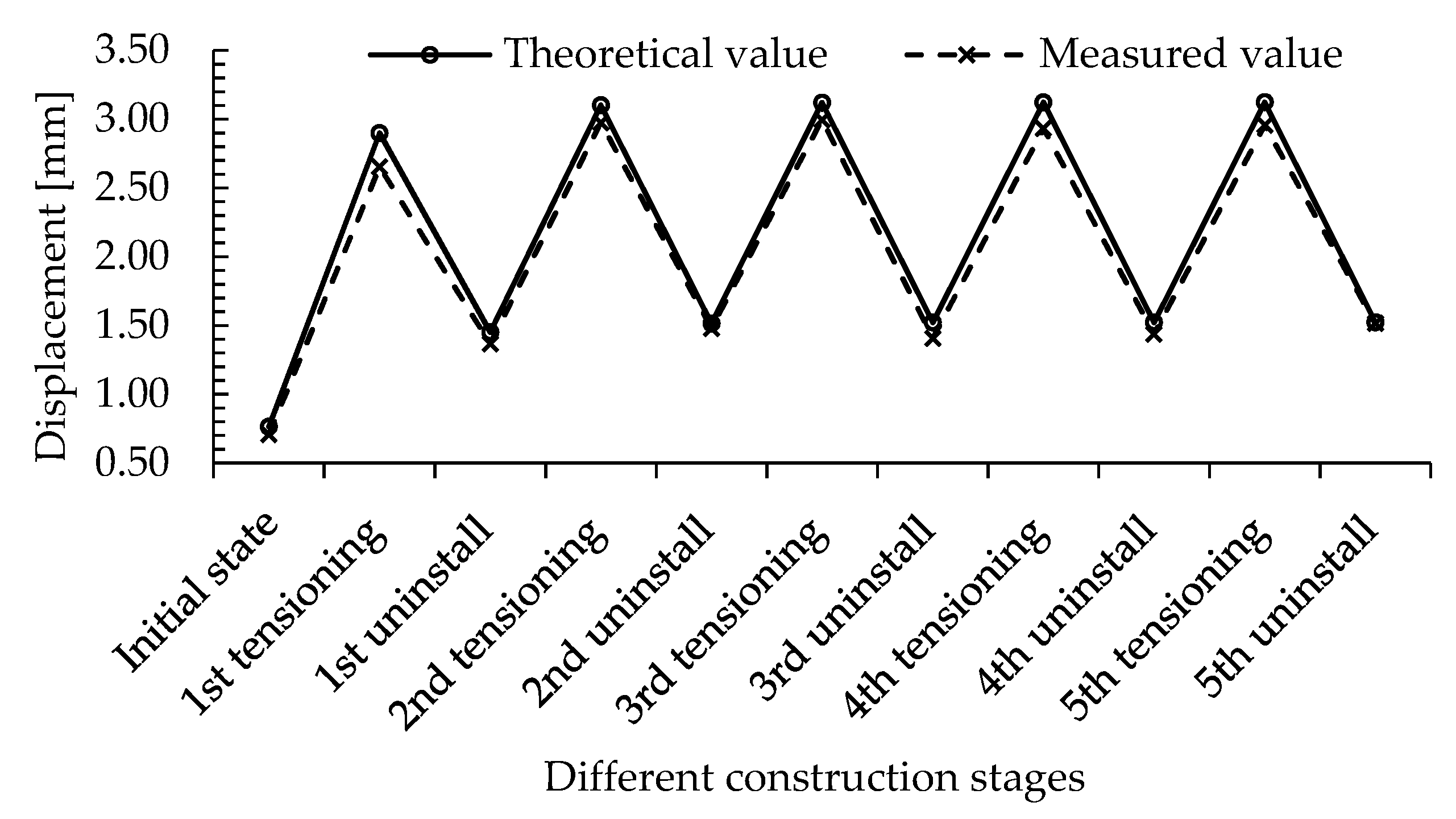

| Cases | ||||||
|---|---|---|---|---|---|---|
| Basic parameter | E = 2.05 × 1011 Pa, L = 27.10 m, E’ = 2.05 × 1011 Pa, A’ = 0.0037 m2, Eb = 2.06 × 1011 Pa, Ib = 0.035 m4, S = 5.10 m | |||||
| Initial state | 0 | 0.0047 | 9.63 × 105 | 27.13 | 0 | 0 |
| 1st pocket hanging | 1.93 × 105 | 0.0047 | 8.96 × 105 | 27.12 | 1.88 | 1.88 |
| 1st cutting | 2.33 × 105 | 0.00376 | 7.58 × 105 | 27.12 | −1.45 | 0.43 |
| 2nd pocket hanging | 3.85 × 105 | 0.00376 | 7.13 × 105 | 27.11 | 1.59 | 2.02 |
| 2nd cutting | 4.28 × 105 | 0.00282 | 5.67 × 105 | 27.11 | −1.53 | 0.48 |
| 3rd pocket hanging | 5.78 × 105 | 0.00282 | 5.31 × 105 | 27.10 | 1.69 | 2.18 |
| 3rd cutting | 6.23 × 105 | 0.00188 | 3.77 × 105 | 27.10 | −1.62 | 0.56 |
| 4th pocket hanging | 7.70 × 105 | 0.00188 | 3.52 × 105 | 27.10 | 1.81 | 2.37 |
| 4th cutting | 8.19 × 105 | 0.00094 | 1.88 × 105 | 27.10 | −1.72 | 0.65 |
| 5th pocket hanging | 9.63 × 105 | 0.00094 | 1.74 × 105 | 27.09 | 1.95 | 2.60 |
| 5th cutting | 1.01 × 105 | 0 | 0 | 27.09 | −1.83 | 0.76 |
| Case | ||||||
|---|---|---|---|---|---|---|
| Basic parameter | En = 2.05 × 1011 Pa, An = 0.0042 m2 | |||||
| Initial state | 0 | 1.01 × 106 | 27.126 | 27.090 | 0 | 0.76 |
| 1st tension | 2.03 × 105 | 9.55 × 105 | 27.118 | 27.090 | 2.13 | 2.90 |
| 1st unload | 2.49 × 105 | 8.11 × 105 | 27.118 | 27.097 | −1.45 | 1.45 |
| 2nd tension | 4.06 × 105 | 7.65 × 105 | 27.111 | 27.097 | 1.65 | 3.10 |
| 2nd unload | 4.56 × 105 | 6.09 × 105 | 27.111 | 27.104 | −1.59 | 1.52 |
| 3rd tension | 6.09 × 105 | 5.64 × 105 | 27.105 | 27.104 | 1.60 | 3.12 |
| 3rd unload | 6.59 × 105 | 4.06 × 105 | 27.105 | 27.111 | −1.60 | 1.52 |
| 4th tension | 8.11 × 105 | 3.61 × 105 | 27.098 | 27.111 | 1.60 | 3.12 |
| 4th unload | 8.62 × 105 | 2.03 × 105 | 27.098 | 27.118 | −1.60 | 1.52 |
| 5th tension | 1.01 × 106 | 1.58 × 105 | 27.092 | 27.118 | 1.60 | 3.12 |
| 5th unload | 1.07 × 106 | 0 | 27.092 | 27.126 | −1.60 | 1.52 |
| Material Type | Applicable Parts | Modulus of Elasticity [kN/m2] | Bulk Density [kN/m3] |
|---|---|---|---|
| 16Mn | Arch rib | 2.10 × 108 | 76.98 |
| OVMLZM7-55III | Old hangers | 2.05 × 108 | 78.5 |
| Finished deformed bar | Temporary hangers | 2.06 × 108 | 100.7 |
| OVMLZM7-55IV | New hangers | 2.05 × 108 | 78.5 |
| C50 | Deck | 3.45 × 107 | 26 |
| Q345 | Main girders and crossbeams | 2.06 × 108 | 100.7 |
| Working Condition | 1+ | 1− | 2+ | 2− | 3+ | 3− | 4+ | 4− | 5+ | 5− |
|---|---|---|---|---|---|---|---|---|---|---|
| Measured [mm] | 1.88 | 0.42 | 2.1 | 0.49 | 2.12 | 0.54 | 2.34 | 0.63 | 2.56 | 0.77 |
| FEM [mm] | 1.75 | 0.4 | 2.16 | 0.47 | 2.24 | 0.59 | 2.53 | 0.6 | 2.61 | 0.7 |
| FMD [%] | −6.8 | −6 | 3.02 | −3.3 | 5.26 | 9.68 | 8.11 | −4.5 | 2.26 | −9.8 |
| Present paper [mm] | 1.88 | 0.43 | 2.02 | 0.48 | 2.18 | 0.56 | 2.37 | 0.65 | 2.6 | 0.76 |
| PMD [%] | −0.1 | −0.1 | 3.94 | 1.18 | −2.5 | −3.5 | −1.1 | −3.1 | −1.6 | 0.92 |
| Working Condition | 1+ | 1− | 2+ | 2− | 3+ | 3− | 4+ | 4− | 5+ | 5− |
|---|---|---|---|---|---|---|---|---|---|---|
| Measured [mm] | 2.83 | 1.43 | 3.19 | 1.55 | 3.03 | 1.55 | 3.19 | 1.48 | 3.04 | 1.51 |
| FEM [mm] | 3.05 | 1.31 | 3.39 | 1.45 | 3.27 | 1.6 | 3.05 | 1.59 | 3.22 | 1.37 |
| FMD [%] | 7.97 | −7.8 | 6.54 | −6.8 | 8.1 | 3.49 | −4.2 | 7.19 | 6.07 | −9.7 |
| Present paper [mm] | 2.9 | 1.45 | 3.1 | 1.52 | 3.12 | 1.52 | 3.12 | 1.52 | 3.12 | 1.52 |
| PMD [%] | −2.5 | −1.7 | 2.74 | 2.37 | −3 | 1.74 | 2.09 | −2.6 | −2.8 | −0.5 |
Publisher’s Note: MDPI stays neutral with regard to jurisdictional claims in published maps and institutional affiliations. |
© 2021 by the authors. Licensee MDPI, Basel, Switzerland. This article is an open access article distributed under the terms and conditions of the Creative Commons Attribution (CC BY) license (https://creativecommons.org/licenses/by/4.0/).
Share and Cite
Wang, H.; Wang, L.; Zhuo, X.; Huang, K.; Wang, X.; Wang, W. Study on the Precise Displacement Controlling Method for a Suspended Deck in the Hanger Replacement Process of an Arch Bridge. Appl. Sci. 2021, 11, 9607. https://doi.org/10.3390/app11209607
Wang H, Wang L, Zhuo X, Huang K, Wang X, Wang W. Study on the Precise Displacement Controlling Method for a Suspended Deck in the Hanger Replacement Process of an Arch Bridge. Applied Sciences. 2021; 11(20):9607. https://doi.org/10.3390/app11209607
Chicago/Turabian StyleWang, Hua, Longlin Wang, Xiaoli Zhuo, Kainan Huang, Xirui Wang, and Wensheng Wang. 2021. "Study on the Precise Displacement Controlling Method for a Suspended Deck in the Hanger Replacement Process of an Arch Bridge" Applied Sciences 11, no. 20: 9607. https://doi.org/10.3390/app11209607







